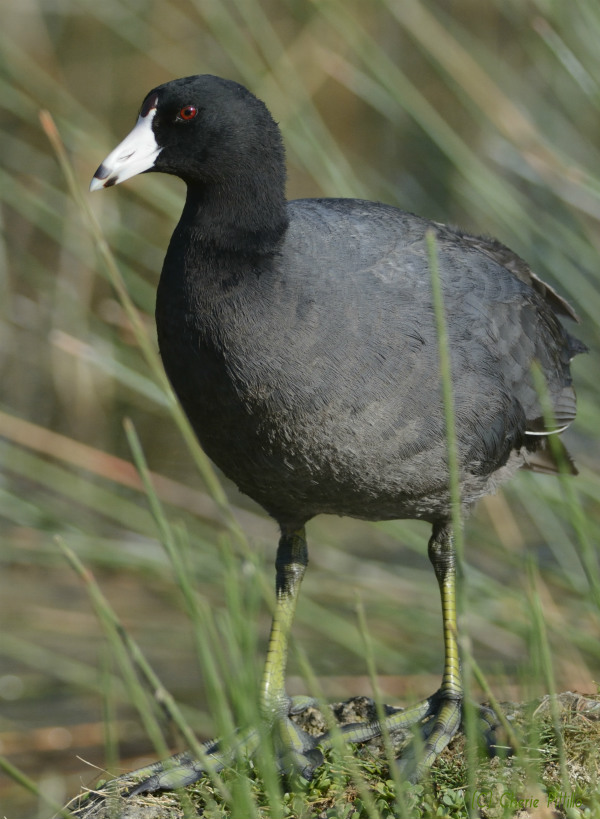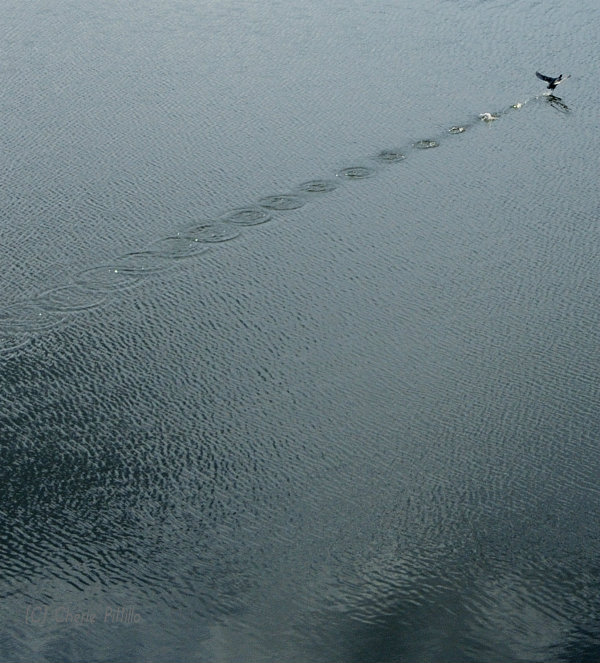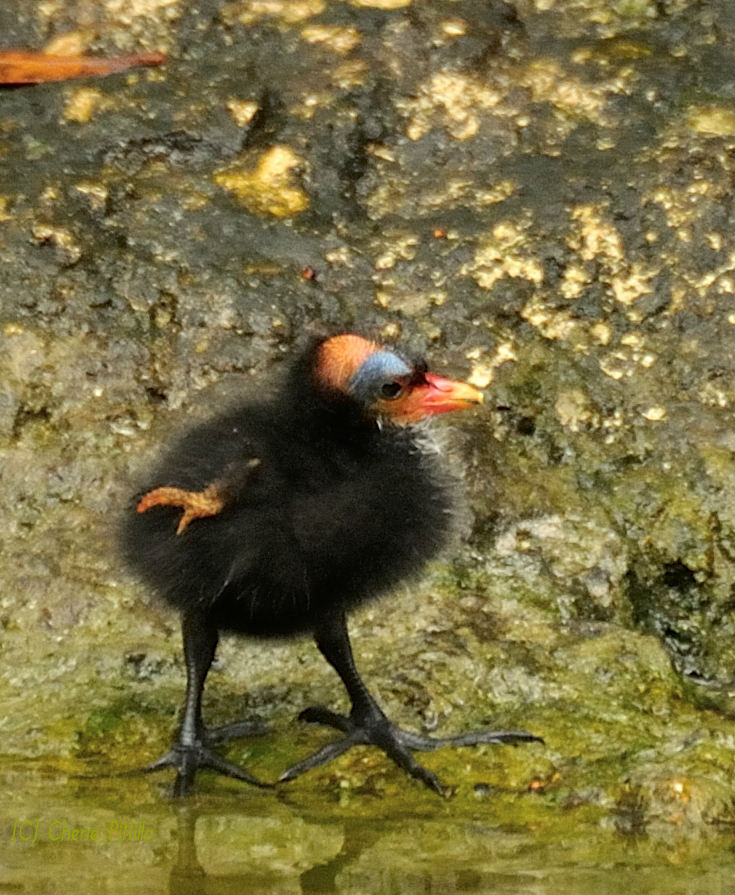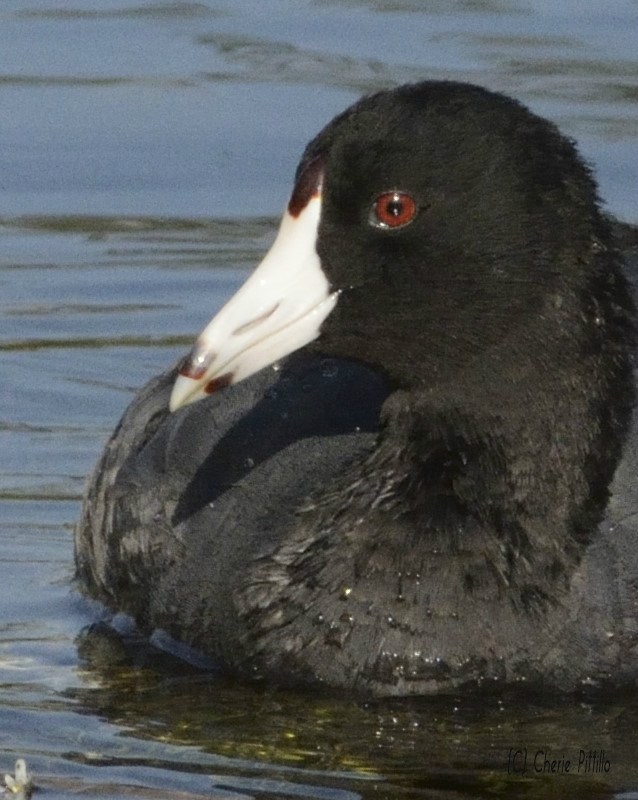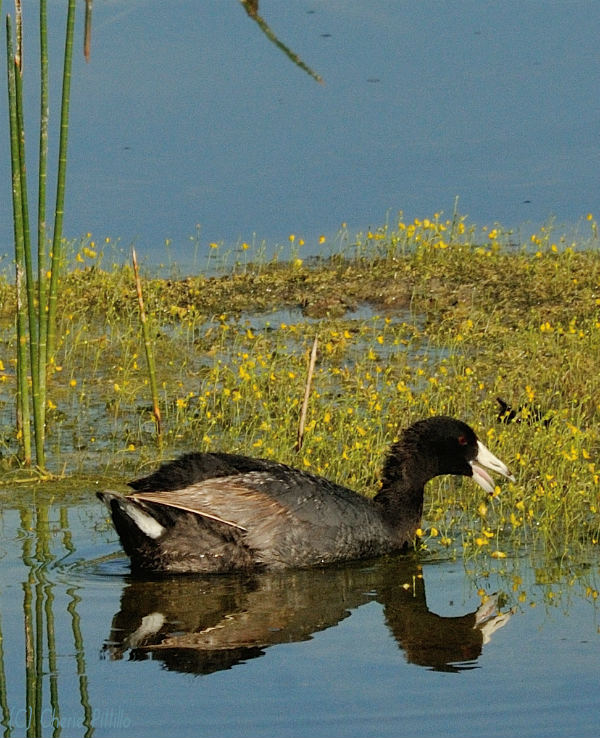Which came first the “old coot” or the American Coot? With the politics in the US now, you might choose an old coot or even an old American coot. But the coot I refer to is the American Coot, the most abundant member of the rail family in North American ponds, lake, marshes, and salt bays. In the Yucatan Peninsula it is a winter resident in coastal areas, marshes, and other wetlands.
Its scientific name, Fulica, derives from Latin for “coot”. In Louisiana, its Cajun name, “pouldeau” translates from French as “water hen”. Many people call it a Mud Hen, due to its taste. Others think it’s a duck.
The chicken-sized American Coot swims in the open like a duck and may often be seen near ducks. Large flocks of over a thousand birds may form a raft or a float. I wonder if in Spanish that would be a ‘flotilla”?
With strong legs and lobed toes instead of webbed feet, it runs on water flapping like crazy to take flight unlike ducks which seem to explode out of the water. Also, it forages on land, such as golf courses.
A monogamous pair may have several nests at one time which can be used for roosting or egg nests or brood nests. The female may lay eggs in other nests before depositing eggs in her own nest. Presumably this could increase chances for more young to survive. BUT, apparently, the American Coot can count her own eggs. A rarity among animals! When another female coot parasitizes a nest by laying eggs, the coot may discard the extra eggs or move them to the edge. She may determine the size of the clutch she will incubate.
Chicks hatch with colored bills, colorful fleshy heads, and orangey head plumes. Scientists refer to these accessories as “chick ornamentation”, which may play a role in identification by their parents and/or in sibling competition. Sometimes, after hatching, the coots appear to recognize chicks laid by another female by their “chick ornaments,” and will kill those chicks or possibly abandon them to die of starvation.
Imagine this coot chick cousin, the Common Gallinule, in the photo below with vivid orange plumes over the front half of its body, brilliant red bill and bald red head. That would be a cute coot chick or a chic chick!
During territorial bouts, a coot lies back in the water and strikes with its feet to rake its claws against an intruder’s chest. It may also try to grab its opponent’s feet while stabbing the other with its bill. Females and other males may join in the fray.
Look at that bill. A frontal shield with a maroon callus adorns the top of its unlike-a-duck bill. I’m not callous about it because the dark red callus and shield intrigue me. According to one source, paired birds or individual coots may recognize each other by the shape of the callus! The callus becomes swollen and lengthens during breeding season or with a maintained territory or just prior to migration. In defense, the coot can erect its feathers behind the shield which may emphasize the size of the callus. A coot with a swollen shield stays dominant over any coots without them.
Although the American Coot primarily eats plant matter, it may dine on fish, insects, and other invertebrates. When it feeds, it looks like a duck as it may dabble at the water’s surface, tip up in shallows, dive underwater, or graze on land.
Although the American Coot can make slightly rough quacks and nasal clucks, hang out with ducks, and its behavior may resemble those of a duck, it’s not a duck. It’s a rail.
Sound link: https://macaulaylibrary.org/audio/2808
Here’s a link to other family members of the rails in the Yucatan:
BACKYARD BIRDING IN MERIDA, YUCATAN AND BEYOND – OFF THE RAILS: THE RAIL FAMILY
COUNT YOURSELF FORTUNATE TO EXPERIENCE NATURE AND EVEN APPRECIATE COOTS!
Mentioned Species:
American Coot, Fulica americana, Gallareta Americana (Spanish)
Common Gallinule, (aka Common Moorhen) Gallinula galeata, Gallineta Frente Roja (Spanish)
DISCLAIMER: References do not agree on details about this species.
http://beheco.oxfordjournals.org/content/15/6/946.full.pdf,
http://www.nature.com/nature/journal/v422/n6931/full/nature01505.html,
http://www.sciencedirect.com/science/article/pii/S000334728371273X,
https://sora.unm.edu/sites/default/files/journals/wilson/v063n03/p0157-p0166.pdf,
http://www.journals.uchicago.edu/doi/10.1086/667191
http://bna.birds.cornell.edu/bna/species/697a/articles/introduction, Sal a Pajarear Yucatan Guia de Aves,
A Guide to the Birds of Mexico and Northern Central America, Birds and Reserves of the Yucatan Peninsula,
http://macaulaylibrary.org/ a website from Cornell Lab of Ornithology, Lives of North American Birds
https://www.allaboutbirds.org/guide/American_Coot/id
Cherie Pittillo, “nature inspired,” photographer and author, explores nature everywhere she goes. She’s identified 56 bird species in her Merida, Yucatan backyard view. Her column, published on the 7th and 21st of each month, features anecdotes about birding in Merida, Yucatan and beyond. Contact: [email protected] All rights reserved, ©Cherie Pittillo


